 No one can dispute the convenience and multifunctional nature of today’s mobile devices. Smartphones, phablets and tablets have all the necessary hardware and a wide range of software features to be able to serve as scanners, presentation remotes and efficient extensions of your desktop or notebook.
No one can dispute the convenience and multifunctional nature of today’s mobile devices. Smartphones, phablets and tablets have all the necessary hardware and a wide range of software features to be able to serve as scanners, presentation remotes and efficient extensions of your desktop or notebook.
One of the biggest features offered by mobile devices is that they can easily capture, organize and share data in many forms.
Wi-Fi or 4G-LTE connected smartphones or tablets may be thin and light but they’re still powerful and capable handheld computers that can be put to great use by students as well as professors in their day-to-day tasks.
The Digital Binder
 Smartphones and tablets have replaced planners, physical notebooks and can even compete with notebooks and chrome book as portable digital binders to capture, organize and share information in various forms.
Smartphones and tablets have replaced planners, physical notebooks and can even compete with notebooks and chrome book as portable digital binders to capture, organize and share information in various forms.
Camera-enabled smartphones and tablets can effectively be used to snap documents, book pages, illustrations and diagrams which can be used as reference, study tools or as part of a presentation.
Consider that flatbed scanners and photocopiers are basically cameras that copy images and store them into files (or print them out), then any 5-megapixel camera on a smartphone or tablet can do just as good or better. Cameras in your smartphone can capture 5, 8 or even 16 million pixels then that’s a lot of room for accurate detail.
Smartphone and tablets are being widely accepted as portable scanners now. You can even deposit a paper cheque to your bank simply using an app on your mobile device to take a picture of it and then submit this to your bank.
While camera specs are important, the apps part of the equation makes using mobile devices as digital binders really effective.
Cloud connected tools
 Digital technology has really changed the way we carry and access information. Instead of having large binders full of pages and clippings, we can store everything virtually in our mobile devices and thanks to various cloud storage services.
Digital technology has really changed the way we carry and access information. Instead of having large binders full of pages and clippings, we can store everything virtually in our mobile devices and thanks to various cloud storage services.
Using services like Box, Dropbox, Microsoft OneDrive or Google Drive makes it easy to automatically back up hundreds of files to the cloud from your device. Which is critical in the event your tablet or smartphone gets, lost, stolen or broken.
A back up strategy is critical, specially for personal information and school or work related documents such as reports, research and other important files. Users should have various points of backup using external drives, a USB thumb drive and a secure cloud-connected backup.
Cloud connected tools, like the ones mentioned above, are also ideal for collaboration. Group projects, documents and reports can be accessed and worked on by various group members simultaneously even if they are physically apart. This is far more effective than emailing various versions of a document back and forth which can create confusion.
Apps that make a difference
 Evernote is one application that helps students capture, organize and store images from multiple devices and makes them accessible via the Web or via companion apps. Evernote is great because it is designed to work like a paper notebook but it is virtual.
Evernote is one application that helps students capture, organize and store images from multiple devices and makes them accessible via the Web or via companion apps. Evernote is great because it is designed to work like a paper notebook but it is virtual.
This means you can enter text by typing, writing on a stylus or by snapping images which are then organized into notebooks or projects for easy reference and review at a later date.
Having all of this information available on a mobile device and on the cloud makes it easy to print out, share and collaborate as needed.
Microsoft Office Lens is another app that really takes technology to another level.
Office Lens trims, enhances and makes pictures of whiteboards and docs readable, and saves them to OneNote. You can use Office Lens to convert images to PDF, Word and PowerPoint files.
Office Lens is like having a scanner in your pocket. Like magic, it will digitize notes on whiteboards or blackboards. Always find important documents or business cards. Sketch your ideas and snap a picture for later. It is great for grabbing images of receipts or stray sticky notes.
Office Lens and similar apps are great for taking and sharing important items without having to manually copy them down. On the whiteboard mode, Office Lens trims and cleans up glare and shadows.
With Document mode, Office Lens trims and colors images perfectly. Pictures are saved to your camera roll and also directly into OneNote, so you can see the images across all your devices. Finally, you can choose to convert images to PDF (.pdf), Word (.docx), or PowerPoint (.pptx) files that are automatically saved to OneDrive.
Another app is Kofax Mobile Capture, users can capture documents, photos, business cards, gift cards and data directly on their Apple iPhone or iPad and deliver the information to core business systems, or processes.
With Kofax, capturing this information at the Point of Origination and delivering it to enterprise applications accelerates processes and reduces costs for better customer service. These new capabilities extend the investment in existing capture processes directly to the iPhone and iPad.
Leveraging Kofax patented VRS image perfection technology directly on the device, documents and content are captured completely and file sizes are optimized reducing transfer times and data plan costs.
For demonstration and evaluation purposes, Kofax provides four example processes out of the box with Kofax Mobile Capture: Business Cards, Documents, Receipts, and Gift Card Balance.
These are additional to any enterprise processes you would make available to your users where Kofax Mobile Capture would automate and accelerate the submission of content and data to process engines, content repositories, workflows, or archives.
Better than a paper copy

The advantage of capturing documents, images and other data using mobile devices is that you have various options on how to handle, edit, save or distribute your documents. Paper is great for when you need to have a final copy of a report or physically proof or edit a document but it is now easier than ever to digitize, edit and share documents, reports and files using mobile devices.



